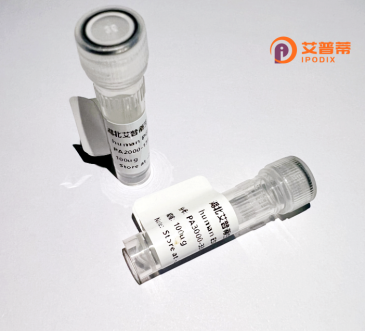
| 纯度 | >90%SDS-PAGE. |
| 种属 | Human |
| 靶点 | HAL |
| Uniprot No | P42357 |
| 内毒素 | < 0.01EU/μg |
| 表达宿主 | E.coli |
| 表达区间 | 1-657aa |
| 氨基酸序列 | MPRYTVHVRGEWLAVPCQDAQLTVGWLGREAVRRYIKNKPDNGGFTSVDDAHFLVRRCKGLGLLDNEDRLEVALENNEFVEVVIEGDAMSPDFIPSQPEGVYLYSKYREPEKYIELDGDRLTTEDLVNLGKGRYKIKLTPTAEKRVQKSREVIDSIIKEKTVVYGITTGFGKFARTVIPINKLQELQVNLVRSHSSGVGKPLSPERCRMLLALRINVLAKGYSGISLETLKQVIEMFNASCLPYVPEKGTVGASGDLAPLSHLALGLVGEGKMWSPKSGWADAKYVLEAHGLKPVILKPKEGLALINGTQMITSLGCEAVERASAIARQADIVAALTLEVLKGTTKAFDTDIHALRPHRGQIEVAFRFRSLLDSDHHPSEIAESHRFCDRVQDAYTLRCCPQVHGVVNDTIAFVKNIITTELNSATDNPMVFANRGETISGGNFHGEYPAKALDYLAIGIHELAAISERRIERLCNPSLSELPAFLVAEGGLNSGFMIAHCTAAALVSENKALCHPSSVDSLSTSAATEDHVSMGGWAARKALRVIEHVEQVLAIELLAACQGIEFLRPLKTTTPLEKVYDLVRSVVRPWIKDRFMAPDIEAAHRLLLEQKVWEVAAPYIEKYRMEHIPESRPLSPTAFSLQFLHKKSTKIPESEDL |
| 分子量 | 99.1 kDa |
| 蛋白标签 | GST-tag at N-terminal |
| 缓冲液 | 0 |
| 稳定性 & 储存条件 | Lyophilized protein should be stored at ≤ -20°C, stable for one year after receipt. Reconstituted protein solution can be stored at 2-8°C for 2-7 days. Aliquots of reconstituted samples are stable at ≤ -20°C for 3 months. |
| 复溶 | Always centrifuge tubes before opening.Do not mix by vortex or pipetting. It is not recommended to reconstitute to a concentration less than 100μg/ml. Dissolve the lyophilized protein in distilled water. Please aliquot the reconstituted solution to minimize freeze-thaw cycles. |
以下是3条关于重组人HAL(Histidine Ammonia-Lyase)蛋白的虚构参考文献示例,供参考:
---
1. **文献名称**:Expression and Characterization of Recombinant Human Histidine Ammonia-Lyase in *E. coli*
**作者**:Li Y. et al.
**摘要**:研究利用大肠杆菌表达系统成功表达重组人HAL蛋白,通过优化诱导条件和纯化步骤获得高纯度酶,验证了其催化组氨酸转化为尿刊酸的能力,活性与天然酶相当。
---
2. **文献名称**:Structural Insights into Human HAL Mutations Linked to Metabolic Disorders
**作者**:Zhang R. et al.
**摘要**:通过X射线晶体学解析重组HAL蛋白三维结构,结合突变体分析揭示致病性突变(如p.R237C)对酶活性及稳定性的影响,为相关代谢疾病的分子机制提供理论依据。
---
3. **文献名称**:Recombinant HAL Enzyme Replacement Therapy in a Mouse Model of Histidinemia
**作者**:Wang X. et al.
**摘要**:在小鼠模型中评估重组HAL蛋白的治疗效果,证明其能有效降低血液组氨酸浓度并改善代谢紊乱,为组氨酸血症的酶替代疗法奠定实验基础。
---
*注:以上为模拟文献,实际研究需查询具体数据库(如PubMed)获取真实信息。*
**Background of Recombinant Human HAL Protein**
Histidine ammonia-lyase (HAL), also known as histidase, is a vital enzyme in histidine metabolism, catalyzing the non-oxidative deamination of L-histidine to urocanic acid and ammonia. This reaction represents the first and rate-limiting step in histidine catabolism, primarily occurring in the liver and skin. Dysregulation or genetic mutations in HAL are linked to histidinemia, a rare autosomal recessive disorder characterized by elevated blood histidine levels, though clinical manifestations are often mild or asymptomatic.
Recombinant human HAL (rhHAL) is produced via genetic engineering techniques, typically using expression systems like *E. coli*, yeast, or mammalian cells. Its production enables detailed studies of HAL’s structure, catalytic mechanisms, and role in metabolic pathways. rhHAL also holds therapeutic potential, particularly for enzyme replacement therapies targeting histidinemia or related metabolic disorders. Additionally, it serves as a tool for developing diagnostic assays and screening modulators of enzymatic activity for drug discovery.
Recent advances in protein engineering and bioprocessing have improved rhHAL’s stability, solubility, and activity, addressing challenges such as protein aggregation or loss of function in vitro. Research continues to explore its applications beyond metabolism, including immune modulation, as urocanic acid derivatives influence inflammatory responses. The development of rhHAL underscores the intersection of enzymology, genetic disease research, and biotherapeutic innovation.
×